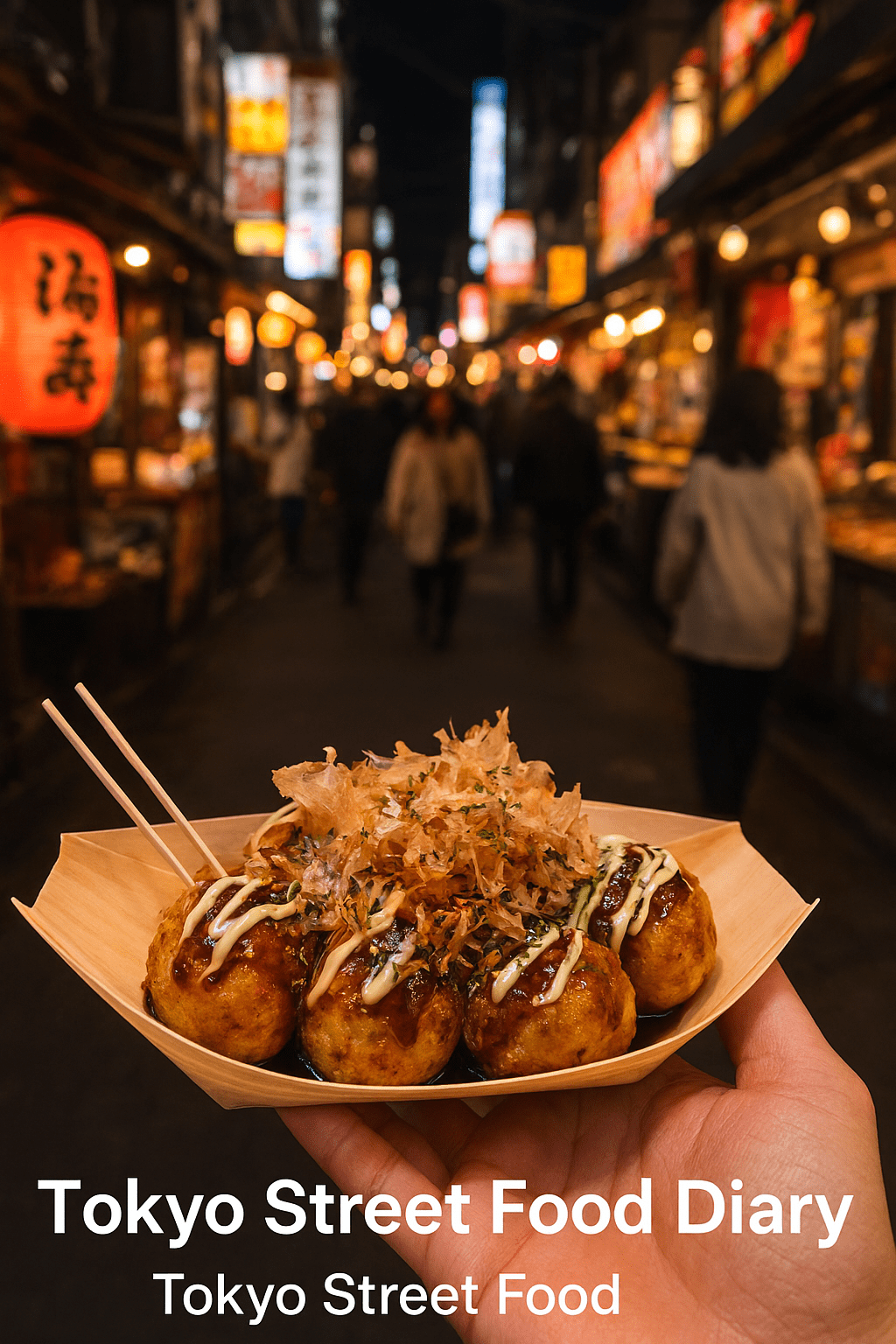From Lisbon’s Alfama to Tokyo’s Akihabara
The journey of flavors continues. After Lisbon’s bifana and pastel de nata, our trail lands in Tokyo, where precision meets playfulness, and every bite is a reflection of the city’s rhythm. Tokyo street food diaries isn’t just about eating—it’s about tracing the pulse of a metropolis through its stalls, konbini aisles, and neon-lit corners. Takoyaki, one of the most beloved Japanese street foods, originated in Osaka and has become a cultural icon. See its history here
Teriyaki – Glazed Intentions


If Lisbon’s bifana was steam and spice, Tokyo’s teriyaki is glaze and glow. Skewers of chicken or beef, brushed with soy, mirin, and sugar, sizzle over charcoal until lacquered with sweetness. The first bite is sticky, smoky, and sharp—Tokyo’s way of saying: welcome to the night market.
Eating teriyaki in Omoide Yokocho, under lanterns and chatter, is a ritual of its own. The glaze clings to your fingers, the smoke lingers in your hair, and the city hums around you.
Takoyaki – The Whirl of Heat

Few street foods capture Tokyo’s playful side like takoyaki. These molten octopus balls, topped with bonito flakes that dance in the steam, are a festival staple. Bite too soon and you’ll burn your tongue, but wait a moment and you’ll taste the balance of batter, octopus, and sauce.
Takoyaki is Tokyo’s laughter in food form—shared with friends, eaten standing, and always paired with the buzz of a crowd.
Yakitori – Lantern Conversations
Yakitori stalls are the soul of Tokyo’s street food night alleys. Yakitori stalls line alleys like Omoide Yokocho and Yurakucho, where skewers of chicken—thigh, wing, liver, or skin are grilled over binchōtan charcoal. Each skewer is a conversation: salty, smoky, and communal. Locals linger with beer in hand, savoring the simplicity of meat and fire.
Onigiri & Konbini Cravings – Pocketed Memory
Tokyo’s street food isn’t only about stalls. Step into any konbini—FamilyMart, Lawson, 7-Eleven—and you’ll find onigiri, melon pan, and egg sandwiches. These are the city’s quiet cravings: portable, affordable, and deeply nostalgic. Eating an onigiri in Ueno Park during sakura bloom is as much a Tokyo ritual as any night market feast. Even konbini snacks are part of Tokyo street food’s quiet cravings.
Sweet Echoes – Crepes & Taiyaki

Harajuku’s crepes, folded with strawberries, cream, or even cheesecake slices, are Tokyo’s neon indulgence. Meanwhile, taiyaki—fish-shaped cakes filled with custard or red bean—offer warmth and whimsy. Together, they echo Lisbon’s pastel de nata: sweet pauses in the city’s rush.
Cravings with a View

Tokyo’s food is inseparable from its landscapes. Teriyaki under Tokyo Tower’s glow, takoyaki by Odaiba’s Rainbow Bridge, or taiyaki on Nakamise Dori with Senso-ji in the background—each bite is tied to a view, a sound, a rhythm.
Street food here is not just about taste—it’s about place. Every flavor sharpens memory, every snack becomes a story.
Practical Tips for Tokyo Street Food Diaries
- Where to go: Omoide Yokocho for yakitori, Harajuku for crepes, Asakusa for taiyaki, konbini for onigiri.
- When to eat: Late night for skewers, daytime for konbini snacks, festivals for takoyaki.
- What to expect: Prices range from ¥150 for onigiri to ¥500–700 for yakitori sets. Affordable, fast, and deeply tied to Tokyo’s rhythm.
- How to enjoy: Stand, eat, move. Tokyo street food is about flow, not formality.
Closing Note
Tokyo Street Food Diaries is the second chapter in our trilogy. If you missed the first, revisit Lisbon Street Food Diaries – From Dadar to Alfama for bifanas, pastéis de nata, and Alfama sunsets.
Next stop: Cravings Across Continents continues as we trace flavors from Tokyo’s neon to Yamagata’s quiet rituals.
“Every city leaves a flavor behind.”
Green White Faq Blog Post by Kash Pals
Continue the Journey
From one street corner to the next, the rhythm never stops. Follow the trail through the Street Food Diaries trilogy:
Mumbai → Where it all begins with vada pavs and cutting chai, the heartbeat of Dadar’s streets.
Lisbon → Bifanas, pastel de nata, and midnight bread ovens in Alfama’s winding alleys.
Tokyo → Teriyaki skewers, takoyaki stalls, and the neon pulse of Shinjuku nights.
Each stop is a chapter, each dish a story. Together, they form a map of flavors, rooted in memory and carried forward in every bite.
The journey doesn’t end—it circles back, inviting you to taste again, to wander again, to discover how food is never just food, but a language of place, people, and time. rituals, and rhythms that cross continents.

